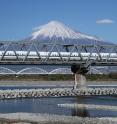On-the-go ultrahigh vacuum storage systems
The train to Tsukuba, Japan often carries workers with briefcases and travelers with overnight bags, but recently a group of scientists took an unusual bit of luggage on board: a suitcase with an ultrahigh vacuum chamber to store air-sensitive clusters of platinum metal. The clusters are of special interest because they're expected to improve catalytic activities such as automotive exhaust reactions and electrochemical reactions.
The researchers wanted to study how the clusters interact with the surface of different materials and how their sizes affect the behavior - both effects which can be observed using a technique called polarization-dependent total reflection fluorescence (PRTF) X-ray absorption fine-structure spectroscopy (XAFS). The technique requires powerful X-rays which can only be produced in a select few light source facilities.
The problem for the research team was that labs capable of XAFS measurements are far from the labs with the atomically precise cluster deposition system needed to make the clusters. The platinum clusters are also extremely air-sensitive, and are harmed by exposure to the atmosphere.
To outmaneuver these challenges, researchers from Toyota Central R&D Labs, Hokkaido University, and AVC Co. collaborated to develop an ultrahigh vacuum (UHV) storage system. As they report in AVS' Journal of Vacuum Science and Technology A, their "suitcase under UHV conditions" makes it much easier to carry and transport samples from one scientific facility to another via public transportation.
Among its key features, the system is designed to be accessible by two different sample manipulation systems. "The sample can receive a flag-style sample plate via a pincer-grip type of wobble stick and a 'key' type of tip-transfer rod," explained Yoshihide Watanabe, the paper's lead author and program manager of the Quantum Controlled Catalysis Program at the Frontier Research Center, part of Toyota Central R&D Labs in Aichi, Japan.
Samples are protected from vibration during transport inside the "special travel suitcase" and outfitted with vacuum conditions within the sample chamber guaranteed to last at least 72 hours, during which time an ion pump is powered by battery.
As many as three samples can be stored and transported at the same time. "Our vertically arrayed design minimizes the required diameter," said Watanabe. "And our compact sample holder 'stacker' enables a reduction in the size of the portable UHV sample storage system for public transportation."
The significance of the group's work is that their portable UHV sample storage system now makes it possible to easily transfer samples between the cluster deposition chamber and PTRF-XAFS measurement chamber under UHV conditions.
Samples for this work were prepared at Toyota Central R&D Labs in Nagakute, Japan, while the PRRF-XAFS measurements were performed at the Photon Factory at the Institute of Materials Structure Science in Tsukuba, Japan.
The distance between these facilities is roughly 400 kilometers (248.5 miles), so the group put their system to the test via high-speed train. "It's possible to travel with the system by high-speed train, bus, and taxi, but it would probably be difficult to travel with it via airplane because of the high level of security checks before boarding," Watanabe noted. "But it's a great advantage to be able to carry three samples at once via high-speed train to reduce the travel time involved."
The group's system will be useful for materials analysis using synchrotron X-ray or particle beams for other air-sensitive materials after minor remodeling. The "key and keyhole" sample manipulating system, which is equipped with a 90-degree rotation lock supported by a coiled spring, enables flexible manipulation and then quick, easy release of the sample holder.
"We anticipate that our portable UHV sample storage system with a key and keyhole sample manipulating system will find widespread use as a standard system for UHV XAFS measurements -- enabling experiments at any light source in the world," said Watanabe.
Source: American Institute of Physics
Other sources
- On-the-go ultrahigh vacuum storage systemsfrom Science DailyWed, 9 Dec 2015, 2:13:37 UTC
- On-the-go ultrahigh vacuum storage systemsfrom PhysorgTue, 8 Dec 2015, 17:03:26 UTC
- On-the-Go Ultrahigh Vacuum Storage Systemsfrom Newswise - ScinewsTue, 8 Dec 2015, 16:42:06 UTC
